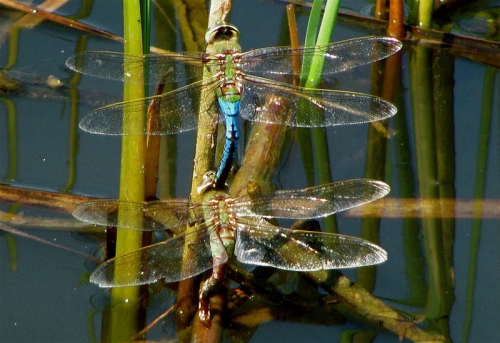Lakefront property owners can protect dragonflies as they reduce mosquito populations
Lakefront property owners who protect and preserve near-shore aquatic plant communities reduce mosquito populations while providing ideal habitats for Mich. dragonflies.
 Lakefront property owners will soon be enjoying quiet summer days on the lake. But what just went zooming by? Perhaps it was a winged predator on the prowl – a dragonfly. Along with insectivorous birds and bats, dragonflies of varying shapes, colors and sizes patrol the shoreline. These masters of the aquatic insect world voraciously prey upon mosquitoes and other insects. To help dragonflies reduce the population of pesky mosquitos, it helps to understand what they need to be successful.
Lakefront property owners will soon be enjoying quiet summer days on the lake. But what just went zooming by? Perhaps it was a winged predator on the prowl – a dragonfly. Along with insectivorous birds and bats, dragonflies of varying shapes, colors and sizes patrol the shoreline. These masters of the aquatic insect world voraciously prey upon mosquitoes and other insects. To help dragonflies reduce the population of pesky mosquitos, it helps to understand what they need to be successful.
Dragonflies spend their lifecycles in and near aquatic environments, and are most abundant in standing waters such as lakes, ponds and wetlands. The young larval dragonfly spends its life in shallow water and, like the adult, preys on smaller organisms that also call the near-shore environment home.
Depending on bottom type and wave intensity, near-shore areas may support emergent aquatic plants. Bulrush is just one example of an emergent aquatic plant. The roots of bulrushes are interconnected and stabilize the lake bottom, reducing sediment movement, scouring and turbidity caused by wind and boat-induced wave action. Lakefront property owners who preserve and protect near-shore plant communities allow young larval dragonflies to site feed more successfully in clear, calm waters.
Emergent plants also provide resting and hiding places for adult dragonflies as they feed and mate. After mating, adult females may deposit eggs directly into quiet waters or onto exposed sediments. Upon hatching, the larva burrows into stable sediments or plant stems. As it grows, it will molt (shed its exoskeleton) several times, becoming free-roaming and predacious. Most species remain in the aquatic stage from one to three years and transform directly from larva to adult. Unlike butterflies, there is no middle (pupa) stage.
The most vulnerable point in the dragonfly’s lifecycle is the transformation from aquatic larva to adult. The larva crawls out of the water onto a vertical surface or plant stem and slowly emerges from its exoskeleton. It may take up to an hour for the wings to unfold, dry out and be ready for flight. Predation by birds, spiders and ants is common. Dense emergent plant communities in the near-shore area can provide cover during this critical time.
Dragonflies are just one example of the many insects, amphibians, reptiles, fish, birds and mammals that benefit from natural shorelines and aquatic plant communities. Lakefront property owners can benefit lake ecology, create dragonfly habitat and reduce mosquito populations by preserving and protecting their near-shore plant communities.
Many fabulous photos of dragonflies are available online. Also, Kurt Mead’s “Dragonflies of the Northwoods” is a colorful and informative field guide to Great Lakes region dragonflies.
Photo credit: Tiwago.



 Print
Print Email
Email

